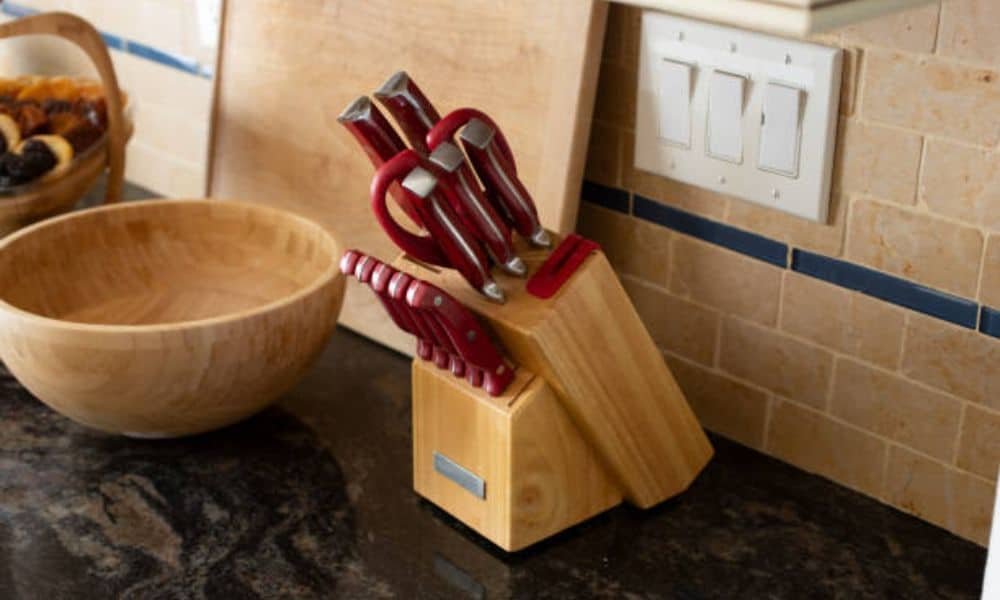I love my kitchen. It’s where the day begins and where stories unfold. I’ve chopped, stirred, and served countless meals here. But for years, one small thing annoyed me—a knife block I couldn’t place right. I tried every spot. Next to the stove? Oil splashes made a mess. Beside the sink? Too much water. In the corner? Couldn’t reach it fast enough. It felt like the knife block was always in the way. That simple block held my best tools. It deserved a home that worked. Good knife storage keeps tools dry, sharp, and close. It also makes cooking faster and safer. Ever thought about where to put knife block in kitchen to make it feel neat and easy to use? I did. And once I figured it out, everything felt better. Even slicing onions became less of a chore. In this guide, I’ll share what worked for me.
Understand Your Kitchen Workflow
Think of your kitchen like a small dance floor. Every move counts. You cut, cook, clean, and serve—all in one smooth motion. How you move shapes your space.
There’s a spot I call the “prep zone.” It sits between the sink and the stove. You rinse, chop, and drop into the pan—all right there. That zone does the most work in your kitchen.
Your knife block should stay close to that area. It needs to be easy to reach. Less walking means faster, safer prep.
Best place for a knife block? Keep it near your prep zone.
It’s not just about speed. It’s also about ease. I once kept my block near the fridge. That meant walking back and forth every time I needed a knife. It slowed me down and wore me out.
Your kitchen layout decides where your knife block should live. It should feel natural, like part of your flow. Not a daily struggle. Watch how you move—your body shows you the best spot.
Where to Put Knife Block in Kitchen: Simple Steps
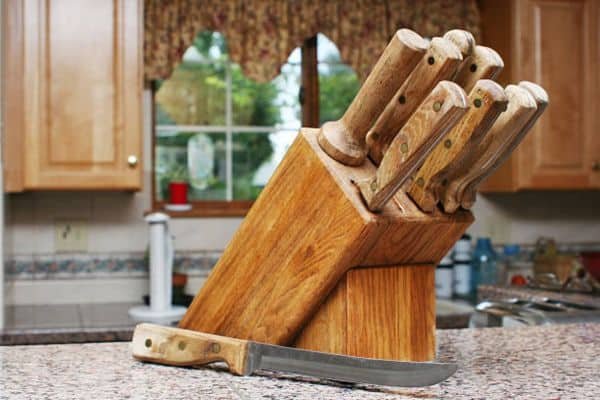
Think about how you cook. You grab a knife, slice your food, and head to the stove. That movement should feel smooth and easy. The block should sit along that path.
Most people chop near the sink or the stove. That’s the prep zone. It’s the busiest area on the counter. This is the best spot for your knife block. Avoid splash zones. Wet blades rust fast. Heat and steam wear them down.
Keep your knife block away from the sink and stove. Now look at your counter corners. Some stay free while you cook. These quiet spots work well for blocks. They stay close without being in the way.
Check the space under your upper cabinets. Make sure each knife pulls out without a bump. You don’t want to hit cupboard doors.
The right spot lets you reach your knives without lifting or twisting.
Leave a little space from the edge. That keeps the block stable. It also keeps small hands safe. Blocks should sit firm, not slide around.
Keep your knives where you can see them. This saves time while you cook. You won’t fumble through drawers. Want easy prep? Make your knives easy to spot and grab.
Practical Knife Storage Ideas for Any Kitchen
Not every kitchen has wide counters or extra drawers. But every kitchen can still store knives well. It just takes the right idea for the space.
The most common choice is a wooden knife block. It’s simple and solid. Most blocks sit on the counter and hold up to 10 knives. Need a quick and classic fix? Go with a wooden block.
Another smart option is the magnetic wall strip. It holds knives flat against the wall. This saves counter space and keeps blades dry. Want clear counters? Use a magnetic strip.
For tight spaces, try in-drawer knife trays. These hold your knives flat in a drawer. They keep things safe and hidden. Best for small kitchens? Use a knife tray in your drawer.
You can also try a pull-down rack under a cabinet. These are rare but clever. They swing out or pull down for access. Like smart storage? Install a pull-out or hanging block.
Some cooks choose universal knife blocks. These use flexible rods inside, not fixed slots. They fit all shapes and sizes. Got unique knives? A universal block gives you more freedom.
There are plenty of knife storage ideas that blend function and style. The best one depends on your habits, space, and tools.
Best Knife Block Placement for Small Kitchens
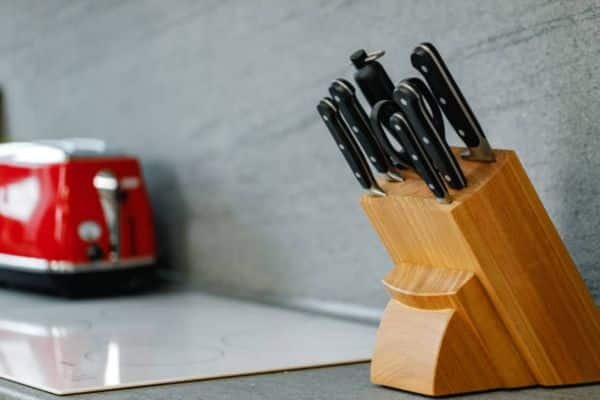
Small kitchens can feel crowded fast. Every inch matters. That’s why smart storage isn’t just helpful—it’s essential.
Start by looking at unused corners. One clear counter edge near your prep space may be all you need.
Small kitchen? Use corners to keep knife blocks out of your way.
Try using vertical space. A magnetic wall strip above your counter frees up space below. It also keeps blades dry and visible.
No counter room? Store knives on the wall instead.
Drawers are another smart move. A knife tray inside a shallow drawer keeps tools safe and flat. This works great in kitchens where counters stay busy.
Need to hide your knives? Store them in a drawer tray.
Tight fit under the cabinet? Try a low-profile block or a pull-out holder. These slide or swing into place, then hide when not in use.
Low on space? Use pull-down or fold-away storage options.
The best knife storage ideas don’t need a big kitchen. They just need smart thinking. Use space that’s overlooked. Let the tools work with your flow.
Choosing the Right Knife Set for Your Storage Plan
Good storage starts with the right tools. There’s no need to own every knife in the world. A few sharp, well-chosen ones can handle almost everything.
Most home cooks need three basics: a chef’s knife, a paring knife, and a serrated knife. These cover chopping, peeling, and slicing bread or tomatoes.
Just getting started? These three knives will serve you well.
Before picking storage, think about what your knives need. Long blades? Go for a block with wide slots. Mixed sizes? Try a universal block or magnetic strip.
Choose storage that fits your actual knives, not just the kitchen style.
If you’re building your set from scratch, don’t overspend. There are great choices out there that offer sharp blades, comfy handles, and solid design.
Want value and quality? Look for the Best Kitchen Knife Set Under 100.
Many brands offer full sets in that range, often with storage included. These are perfect for beginners or anyone upgrading their tools without stretching the budget.
Common Mistakes to Avoid
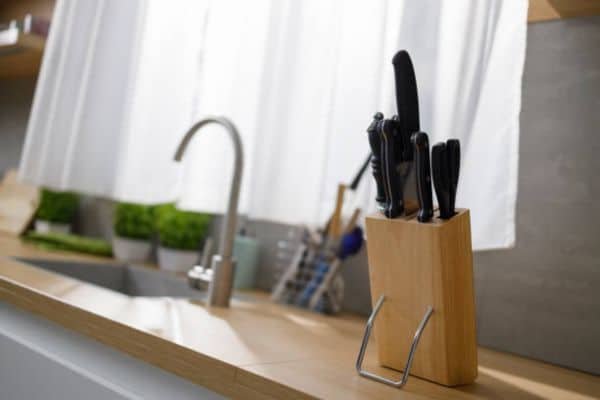
Even a good knife can feel bad in the wrong place. Some habits may seem fine at first but cause long-term problems. A few small changes can protect your tools—and your hands.
Mistake 1: Placing the block near heat or water
Heat dulls blades. Moisture leads to rust. That’s why spots near the stove or sink should be off-limits.
Mistake 2: Letting kids reach the block
Knife blocks on the edge of the counter are risky. Kids may grab a handle without knowing the danger. For safety, keep your block a few inches back from the edge.
Mistake 3: Ignoring airflow
A block pushed into a tight corner can trap moisture. That creates a musty smell—and dull blades. Let air move around your block to keep it dry and fresh.
Mistake 4: Storing dirty or wet knives
Putting a knife back without drying it first spreads bacteria. It also damages the block over time.
Always clean and dry before storing. It takes seconds and saves your tools.
Mistake 5: Using too many knives at once
Some people load blocks with every blade they own. This crowds the slots and makes tools hard to grab. Stick to the knives you use most. Store extras in a drawer.
Pro Tips to Make Knife Storage Work for You
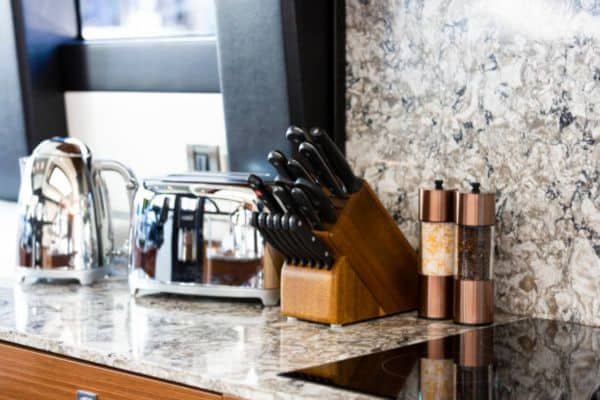
You’ve found the right spot. Now it’s time to keep things running smooth. A few smart habits make all the difference.
Wipe the block once a week. Dust, crumbs, and grease collect fast. A quick wipe with a damp cloth keeps the block clean.
Want a tidy counter? Clean the block like any other kitchen tool.
Use a non-slip mat underneath. Some blocks slide on slick counters. A rubber mat keeps them steady and safe. No more slipping or shifting—just a stable, solid base.
Add a small board nearby. Keeping a cutting board close to your block saves steps. It also helps build a natural rhythm. Set up a mini prep zone with a board, knives, and space to chop.
Rotate your knives now and then.
We all have favourites. But using the same one every day wears it out faster. Switch things up to keep edges sharp and tools balanced.
Check for fit every few weeks.
Knives should slide in and out with ease. If they stick or wiggle too much, it may be time to clean or adjust. Smooth access means safer slicing and less stress.
Final Thoughts
A good kitchen feels easy. Every tool has a place. Every move feels smooth. That’s the goal—not just a tidy space, but a kitchen that works with you.
Finding where to put knife block in kitchen may seem small. But it changes how you cook. It saves time. It keeps your hands safe. And it brings calm to the rush of dinner prep.
Smart placement turns a cluttered corner into a true prep zone.
There’s no one-size-fits-all answer. Your space, your habits, your tools—they all shape the right choice. Trust what feels natural. Let your setup match the way you move.
Knife storage is about more than sharp blades. It’s about comfort, flow, and care. With the right plan, even small shifts can lead to big wins in the kitchen.

